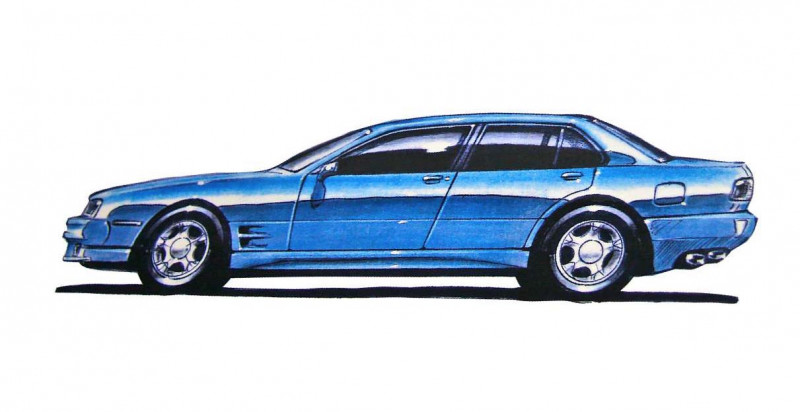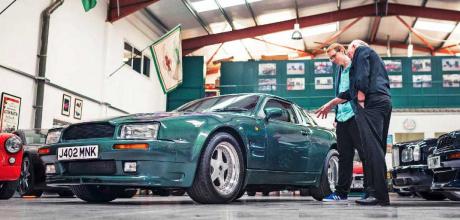ex-Works Service mastermind David Eales
Heading up Works Service meant David Eales travelled the world selling special Aston Martins. Few were asspecial as those sold to the Brunei Royal family…
Words NATHAN CHADWICK
Photography OLIVER BROOKWELL
ex-Works Service mastermind David Eales talks about his surreal days serving up specials for Brunei Royals
[Interview]
Serving up for the Sultan

‘They always ordered six. We had to promise not to make these specials for anyone else’
The first time I went out there in 1990 I was dead nervous,’ remembers David Eales, as we leaf through the hand-notated drawings of the weird and wonderful bespoke creations of Aston Martin Works in his mezzanine office above Oselli’s workshops. ‘I was expecting a Buckingham Palace-type affair, but when we pulled up it was like a village. The gates opened up and we drove through a golf course, and over on one side was the Sultan’s mansion, on the other his brother Jefri’s. As we went past the Sultan’s house, there were six Jaguar XJ220s outside.’ Now, those with a keen interest in Jaguar history might think we’ve got the dates wrong, but no. ‘They hadn’t been released in the UK yet – but the Sultan had the first of everything,’ remembers David. ‘One of the XJ220s was stripped. I asked if they needed help getting it going – they said “No, we use this to keep the others going.”’ David had been heading up Aston Works Service since 1987, having started at Newport Pagnell as a technician in 1975. His job was to keep VIP customers happy and coming back for more bespoke creations. ‘I remember a German customer being adamant that his Virage 6.3 wouldn’t do the 180mph I said it would,’ remembers David. ‘So I went to Germany and took him on the autobahn. I didn’t see what speed we got up to but my knuckles were white and he didn’t complain any more.’
However, it was Brunei’s royal family that would prove to be the most important Aston Martin clients of the time. The Sultan and his brother Jefri lavished cash around with seemingly little restraint – aside from the enormous 2000-strong car collection for which they are famous, Jefri had his own private Boeing 747, as well as hotels in Paris, Los Angeles, London, Las Vegas and New York. He also owned a yacht called Tits, with a pair of tenders called Nipple 1 and Nipple 2. Aston Martin, whose bank account was rarely anything other than an accountant’s nightmare, was among many luxury manufacturers who were pretty much solely sustained through the recession-hit late Eighties and early Nineties by the extravagant bespoke commissions from Brunei. Aston Martin would produce a number of variants based on the Virage, but it would also build bespoke DB7-based creations. AMG produced thousands of tuned Mercedes, Bentley catered to every Continental R-based whim, and Pininfarina did good business with one-off cars and luxury-focused, rhd Ferrari F40 and 288GTO conversions. For Aston Martin, there was money to be made, and what started as long-wheelbase conversions soon moved into more bespoke creations. ‘They would always order six, always in the same colours – yellow for Prince Jefri, black for his son, and so on,’ says David. ‘We had to promise not to make these specials for anyone else.’
Those specials have passed into legend – the walls of Oselli are adorned with four-door and shooting-brake versions of 6.3-litre converted Virages, but David pulls out a thick, wooden-backed book, showing more extravagant creations that were considered. ‘I used to take this to Brunei to show them our designs,’ David explains. ‘Martin Loasby was ex-Lotus, and after the disaster of DeLorean came to Aston as a subcontract design engineer, and ended up doing all sorts of stretch vehicles.’ Leafing through the catalogue, there are plenty of fascinating machines, including an even more hardcore-looking Virage.
Most got made, but the pick-up remained just a pipe dream, while others, such as the DB5-alike built on DB7 underpinnings, did go ahead. ‘We made modified Virage Volantes where the hood stacked inside the cars with a flat top. I’ve never seen one outside Brunei; we spent a lot of time doing those,’ David says. Time was certainly something that couldn’t be rushed at the royal palace. ‘We rarely dealt with the Sultan, we dealt with Prince Jefri or his son. We’d be called out there urgently, and they’d put us up in the hotel for three or four days. Then we’d be called for our appointment and give a presentation.’
This meant that there was a lot of milling around, which meant David got to mingle with representatives of Bentley, Pininfarina and many more over dinner. ‘I remember Peter Ward [then-chairman of Bentley] being there, as well as the guys from Pininfarina; there’d be all these people there doing business, waiting their turn to go in, a little car hub of people.’
There was a team of local mechanics tending to the cars, which David and others would train. ‘They were all very good to me. One time I remember being asked by the chief mechanic to come to a family gathering. We went to another private hotel and there was a big table laid out; all the mechanics were there with their kids. After the waiters had served us, the karaoke machine would go on and they’d start singing.’
Extending the vocal chords wasn’t just the preserve of the waiting staff, however. ‘Brunei is supposed to be a “dry state”, but the waiters would come around offering us a teapot, which turned out to be full of Heineken,’ says David with a chuckle. ‘By the end of the evening we’d all be very merry, and of course they’d pass the microphone over. I was a bit of a reserved Brit, but the waiters fortunately joined in.’
The cars were stored in extensive workshops, with a small army of technicians tending to the cars. ‘There were a load of single-storey buildings, each one dedicated to a marque – Aston Martin, Bentley and so on, and the first thing you’d notice is the air conditioning,’ David says. The situation is different now – inter-familial strife put a hold on the Sultan and Jefri’s rampant spending and the air-con was turned off, with the doors opened on most of the buildings. Thousands of cars, mostly Mercedes- Benzes, have apparently been damaged beyond repair by the heat. Some cars have escaped from Brunei, such as the black Ferrari 288GTO featured in the December 2017 issue of Classic Cars, while more recently, a host of AMG models have come up for sale in the UK. The truly special machinery, including half a dozen McLaren F1s and any number of special-bodied Astons and Ferraris, are still in Brunei being looked after, but lots of cars were less fortunate. ‘I believe to this day that there’s probably a load of rusty old cars out there,’ reflects David.
David has fond memories of Brunei. ‘I loved my time there, it was hot and I hated that they’d summon me on a Sunday for a meeting on Monday and keep me hanging about, but they were good people and I had a great time,’ David reflects. Aston Martin Works was doing very well – with a 50-strong team they were getting through a lot of work, filling Aston’s coffers. But not every special-bodied Virage ended up with the Sultan – one shooting brake was bought by a German customer.
With David criss-crossing the globe making orders, devising, designing and test driving the new 6.3 Virage and plenty more besides, you would assume new owner Ford must have been happy. Not so, as David explains, ‘A Ford finance guy came into my office and said they weren’t sure about all this work I was doing; Ford frowned upon altering production cars because of the risk, safety and type-approval factors,’ says David. ‘I said to them, “Well, Aston Martin has done quite well out of it.”
‘They also said they didn’t approve of me flying club class, so I said I can’t go then, go yourself. All these things led to a bit of an edge, and it was time for me to move on.’ David left to join Oselli, and Aston Martin wound down its bespoke creations section. Meanwhile, David has developed Oselli into a diverse restoration and race preparation firm. While best known for Astons and MGs, you might find a Mustang, Ghibli or even a Venturi Atlantique being tended to; it also recently lent its name to the David Brown Automotive Oselli Edition Mini. However, it’s clear there’s a lot of affection for his time leading Aston Martin’s VIP section, particularly in Brunei. ‘It was an unbelievable time really, but lots of good memories.’
‘The waiters came around offering us teapots full of Heineken
David talks Nathan through the scope of modifications made by Works Service The lesserspotted Flush-fitting- top Virage Volante David once had to max out the 6.3’s capabilities on a German autobahn One of very few Shooting Brake Virages built.
Project Minky evolved out of the Works Service modification programme Hand-edited drawings for the DB7-based ‘DB5’ homages of the Nineties Minky gets ready for the Brighton Speed Trials Minky during the build process.
One of the many hand-drawn proposals for the Brunei Royal Family.
Hand-edited drawings for the DB7-based ‘DB5’ homages of the Nineties Minky gets ready for the Brighton Speed Trials Minky during the build process. David headed up Works Service in the late Eighties and early Nineties.


